With its seemingly infinite capacity to answer questions, create photorealistic images, and write computer code, generative AI has been heralded as the next era in technology, akin to the personal computer, the internet, and the smartphone. Indeed, AI has suddenly appeared in everything, everywhere, and all at once. Over the last two years, venture investment in generative AI rose 120% to USD 20.3 billion in 2023, the mention of AI during quarterly earnings calls within the S&P 500 nearly doubled and sales of technologies underpinning AI have risen three-fold. With that level of momentum, taking a critical view to separate the signal from the noise would also be prudent.
With AI expected to represent a multi-year opportunity, we have to take a step back to review the current state of the technology, outline our investment approach, and highlight the opportunities within enterprise software, cybersecurity, industry, robotics, and consumer technology.
Great expectations
In the 1960s, Stanford University professor Roy Amara noted that “we overestimate the impact of technology in the short term and underestimate the effect in the long run.” Expectations for AI do not appear muted. Goldman Sachs estimates that up to a quarter of all jobs in the US and Europe could be automated by AI, while PWC forecasts that AI will add USD 15.7 trillion to global GDP by 2030. Although the current set of companies with clearly measurable revenues derived directly from AI is small, more than a third of companies in the S&P 500 discussed AI on earnings calls during 2023.
Figure 1: Mentions of AI within S&P 500 members’ earnings calls
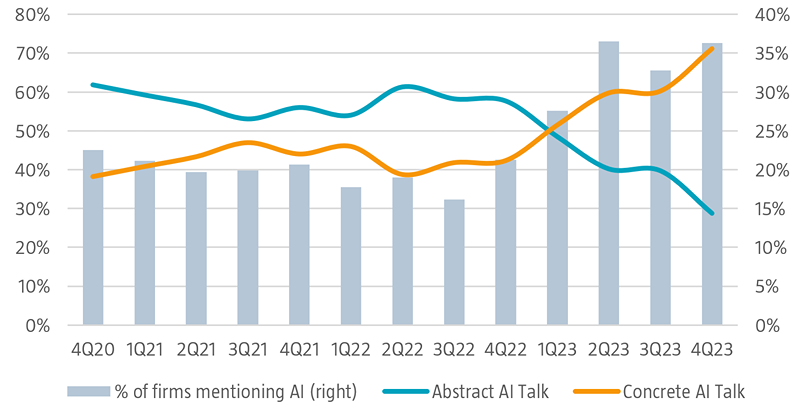
Source: Robeco, FactSet, March 2024.
Our approach
In previous technology eras, a handful of firms providing foundational intellectual capital captured the majority of the value creation across the cycle. For instance, this was the case for IBM in the mainframe era, Microsoft and Intel in the PC era, Apple and Qualcomm in the mobile era, and Amazon and Google in the internet era. In the case of artificial intelligence, chipmaker Nvidia has positioned itself as the effective standard for developers by pairing its ultra-fast parallel processing technology with their widely adopted software platform, CUDA.
While the impacts of structural changes and transformative shifts are broadly felt, there are typically few beneficiaries. According to a study by Hendrik Bessembinder from Arizona State University, when examining the returns of 64,000 global stocks, the top performing 2.4% of companies accounted for 100% of the USD 75.7 trillion in wealth creation between 1990 and 2020. 1
Figure 2: Distribution of US equity market returns between 1973 and 2020
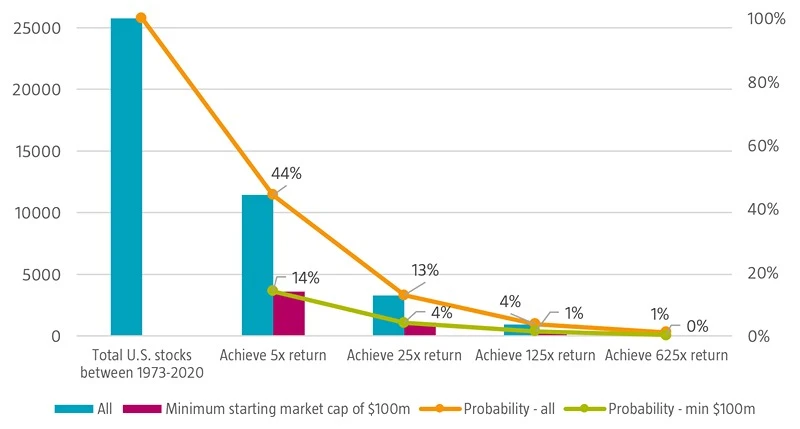
Source: H. Bessembinder, Arizona State University, 2021.
That being said, similar to the internet and enterprise software, artificial intelligence is not a singular technology, there are many forms of AI. For instance, as Software as a Service (SaaS) models developed, several dominant platforms emerged focused on specific functions like Salesforce.com in customer relationship management, ServiceNow for IT support, and Workday for human resources. The emergence of AI may serve to strengthen those services, or facilitate new entrants. Moreover, while much of the focus today centers on generative AI, applied AI and machine learning, other tools continue to evolve in applications across automation, cybersecurity, logistics, and robotics. As a result, there exists broad potential for multiple profitably scaled businesses to emerge from the new wave of AI development.
Industrial AI
While consumer applications like chatbots and image generators have garnered the most attention recently, AI has been at the center of industrial strategy for more than a decade. By augmenting robotics and other infrastructure with sensors connected by networks to software, the Internet of Things (IoT) is already having a material impact on operations and margins. For example, working with Microsoft, BMW deployed an IoT system that the automaker credited with reducing one factory’s metal-press shop downtime by 25%.
Figure 3: Industry 4.0 combines sensors, data, cloud computing, robotics, and artificial intelligence to form smart manufacturing
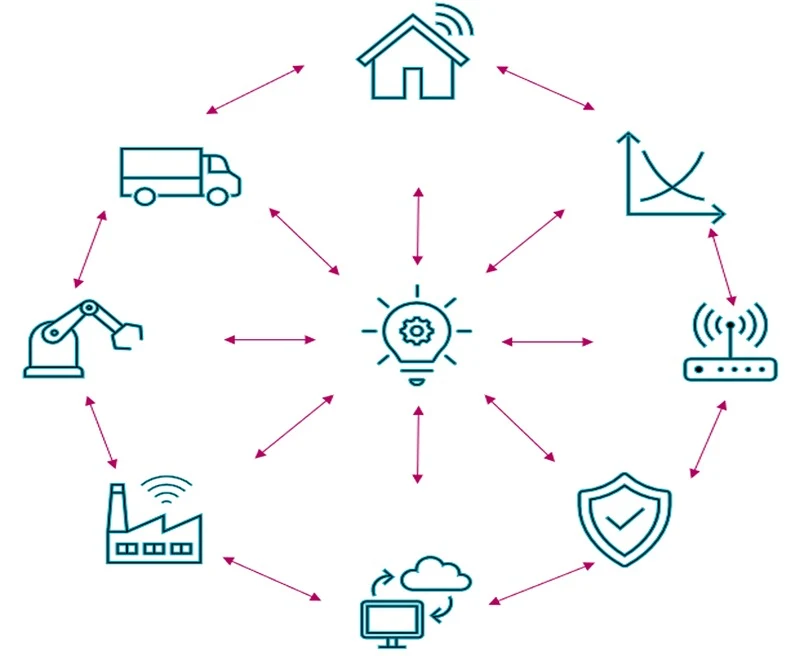
Source: Robeco.
Robotics
By learning from human controls and taking input from sensors and cameras, robotic production is poised to become more efficient and more flexible. For instance, Google DeepMind’s RT-2 AI model was trained on both robotic-specific data as well as from the web to enable machine vision equipped robots to perform tasks that were not preprogrammed.
Figure 4: Google DeepMind robotic arm performs tasks not contained in pre-defined instructions
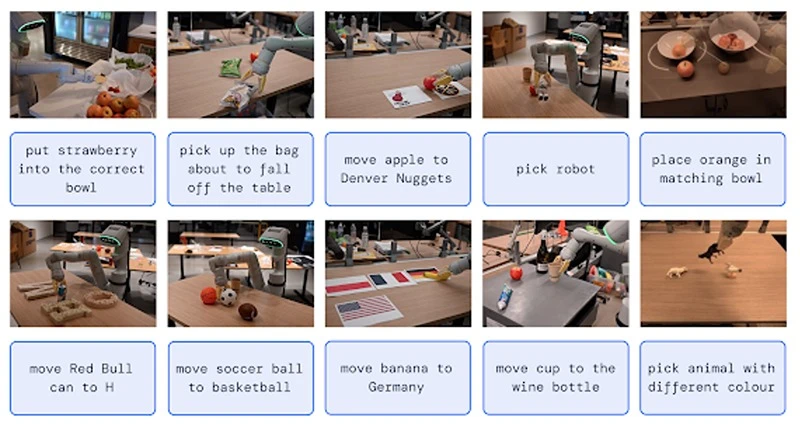
Source: Google DeepMind.
Enterprise AI
Combining advanced analytics with generative AI’s capacity to put trends into words, the promise of big data could be realized. Indeed, companies are already integrating AI technologies to automate workflows, improve customer service, and bolster cybersecurity measures.
Software
AI also presents a significant opportunity for the software industry to enhance existing applications, create new applications not previously feasible, and to improve the productivity of software developers. Research firm Gartner estimates that AI accounted for 8% of software revenues in 2023, a figure the firm expects to reach 35% by 2027.
Cybersecurity
Developments in the field of AI offers security professionals new tools to combat increasingly sophisticated cyberattacks. Today’s cyber protection systems employ machine learning and behavioral analysis to detect threats based upon actions rather than signatures alone. Beyond just detecting threats, generative AI also offers the potential to automate the response to the continuous stream of attacks.
At home
With its ease of use and its ability to answer a seemingly infinite range of questions, the launch of ChatGPT has sparked consumer imaginations. According to Pew Research, as of the first quarter of 2024, 23% of US adults have used the service. But the nascent tech isn’t really entirely new, as AI and machine learning have long been correcting spelling errors, enabling secure biometric mobile payments, and more recently making content recommendations on Netflix and TikTok.
Figure 5: US ChatGPT use by age
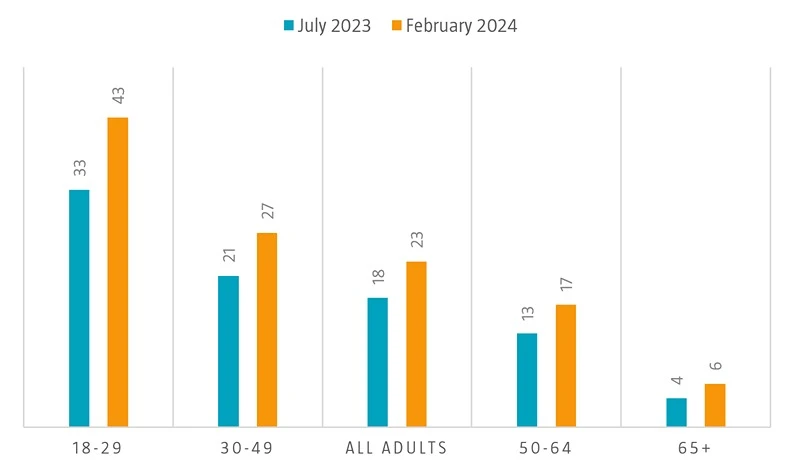
Source: Pew Research Center, March 2024.
On the road
Although widescale deployment of autonomous vehicle transportation may still be years away, AI-assisted features like lane-departure corrections and automatic braking are having a material positive impact on safety. For instance, according to Tesla’s 2023 annual impact report, Tesla vehicles with autopilot engaged were involved in 88% fewer accidents per million highway miles driven than the US average.
Digital innovations
At school
While concerns students hand their homework to ChatGPT to complete are not unfounded, the technology is proving useful. For instance, at the University of Texas, history professor Steven Mintz asks his students to use ChatGPT to help write essays while requiring they annotate the process, including listing prompts used, corrections made, and source material referenced. In addition, the free education non-profit Kahn Academy is leveraging AI to create personalized tutors that will learn the strengths and weaknesses of each student to help focus learning.
In healthcare
With more than USD 4.5 trillion spent annually on healthcare in the US alone, even marginal improvements derived from AI could have an enormous impact. AI is increasingly applied in radiology to enhance image segmentation, computer-aided diagnosis, and predictive analytics. Most notably, AI is greatly accelerating the pace of advanced medical research and assisting the drug discovery process. In 2022, Google DeepMind AlphaFold accurately predicted the 3D structures of every known protein (roughly 200 million) to within the width of an atom.
AI risks and concerns
The outlook for AI spans a near infinite range from eternal prosperity to great peril. On the one hand, PWC forecasts that AI could add USD 15.7 trillion to the global economy by 2030. On the other, however, several leaders in the field including Open AI CEO Sam Altman have noted the technology poses an existential risk to humanity. While extinction may seem like a stretch, it is not difficult to find examples of AI software deviating from its intended use.
For example, while generative AI systems have become remarkably adept at producing coherent answers to an ever widening array of topics, they are also very often wrong. In one of the more notable errors from last year, ChatGPT provided multiple detailed yet non-existent case law precedents and judicial findings that lawyers submitted to a US federal court.
As has been the case with previous automation technology cycles, many have expressed concern that AI will take job opportunities from humans. However, this is not necessarily true, as for example demand for accountants continued to expand with the advent of calculators, spreadsheets, and software. As MIT economist David Autor found, “Sixty percent of workers today are employed in occupations that did not exist in 1940, implying that over 85 percent of employment growth over the last 80 years is explained by the technology-driven creation of new positions.”2
AI is also seen as a potential contributor to global warming, with the International Energy Agency forecasting the technology will lead to a 73% jump in data center energy demand. However, efficiency gains may greatly limit the impact. As a study by Ericsson and the International Telecommunications Union found, the technology and communications share of global energy use remained stable at 4% between 2007 and 2020, while the amount of data traffic rose 40-fold.3
Figure 6: Technology sector electricity usage, terawatt-hours (TWh)D
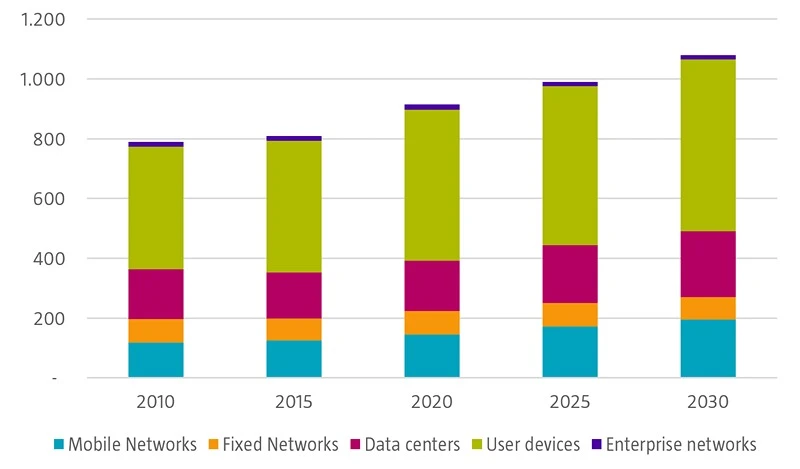
Source: Ericsson, International Telecommunications Union, 2023.
The early approach to internet regulation, based on principles such as net neutrality, self-regulation, and the safe harbor doctrine, was seen as a way to foster growth and innovation of the technology. However, this laissez-faire approach also created opportunities and incentives for bad actors to exploit the internet. Cybercrime, fraud, and social media manipulation have resulted in direct theft, business interruptions, privacy violations, and election interference. The more recent policy response to technology – including issuing billions in fines, the EU’s General Data Protection Regulation, and an acceleration of antitrust investigations on multiple continents – suggests regulators are likely to police AI more strictly than the internet.
Conclusion
Artificial intelligence is intertwined with every trend we follow in the Robeco Digital Innovations strategy. In our Robotics & Automation trend, AI and machine learning have long been hard at work improving efficiency and reducing waste. Production bottlenecks, labor shortages, and geopolitical security considerations have driven renewed interest in reshoring manufacturing, where AI, robotics and automation will play an expanding role.
Beyond manufacturing, from agriculture to logistics and transportation, nearly every sector of the economy is in some stage of a digital transformation. Our Digital Enablers trend is benefiting directly, with enterprise spending on software expanding at a 9.6% compound annual growth rate in the past five years. The improving scope and capability of AI is likely to drive an acceleration in software investment, particularly for cloud computing, a segment which is already expanding at a 26.7% CAGR.
In our Secure Digital Infrastructure trend, expenditure on IT security is expanding rapidly as traditional threats mutate and the potential attack surface widens. AI is positioned to better detect threats and automate responses. Moreover, the intensive computational requirements of AI is also driving accelerated investments in the underlying infrastructure where hyperscale cloud networks are taking share from traditional on-premise enterprise solutions.
In constructing a relatively concentrated portfolio, we seek to identify innovative, quality companies holding or building leadership positions in their respective domains, and we focus on those delivering consistent profitable growth. We believe this investment approach is capturing the companies that are benefiting from direct investment in AI, and those that are leveraging AI most effectively in the real economy.
Footnotes
1 See Bessembinder et al: Long-Term Shareholder Returns: Evidence from 64,000 Global Stocks (2023).
2 The labor market impacts of technological change, D. Autor, NBER July 2022
3 ICT sector electricity consumption and greenhouse gas emissions – 2020 outcome; February 2024, J. Malmodin, N. Lovehagen.
最新のインサイトを受け取る
投資に関する最新情報や専門家の分析を盛り込んだニュースレター(英文)を定期的にお届けします。
重要事項
当資料は情報提供を目的として、Robeco Institutional Asset Management B.V.が作成した英文資料、もしくはその英文資料をロベコ・ジャパン株式会社が翻訳したものです。資料中の個別の金融商品の売買の勧誘や推奨等を目的とするものではありません。記載された情報は十分信頼できるものであると考えておりますが、その正確性、完全性を保証するものではありません。意見や見通しはあくまで作成日における弊社の判断に基づくものであり、今後予告なしに変更されることがあります。運用状況、市場動向、意見等は、過去の一時点あるいは過去の一定期間についてのものであり、過去の実績は将来の運用成果を保証または示唆するものではありません。また、記載された投資方針・戦略等は全ての投資家の皆様に適合するとは限りません。当資料は法律、税務、会計面での助言の提供を意図するものではありません。 ご契約に際しては、必要に応じ専門家にご相談の上、最終的なご判断はお客様ご自身でなさるようお願い致します。 運用を行う資産の評価額は、組入有価証券等の価格、金融市場の相場や金利等の変動、及び組入有価証券の発行体の財務状況による信用力等の影響を受けて変動します。また、外貨建資産に投資する場合は為替変動の影響も受けます。運用によって生じた損益は、全て投資家の皆様に帰属します。したがって投資元本や一定の運用成果が保証されているものではなく、投資元本を上回る損失を被ることがあります。弊社が行う金融商品取引業に係る手数料または報酬は、締結される契約の種類や契約資産額により異なるため、当資料において記載せず別途ご提示させて頂く場合があります。具体的な手数料または報酬の金額・計算方法につきましては弊社担当者へお問合せください。 当資料及び記載されている情報、商品に関する権利は弊社に帰属します。したがって、弊社の書面による同意なくしてその全部もしくは一部を複製またはその他の方法で配布することはご遠慮ください。 商号等: ロベコ・ジャパン株式会社 金融商品取引業者 関東財務局長(金商)第2780号 加入協会: 一般社団法人 日本投資顧問業協会



















